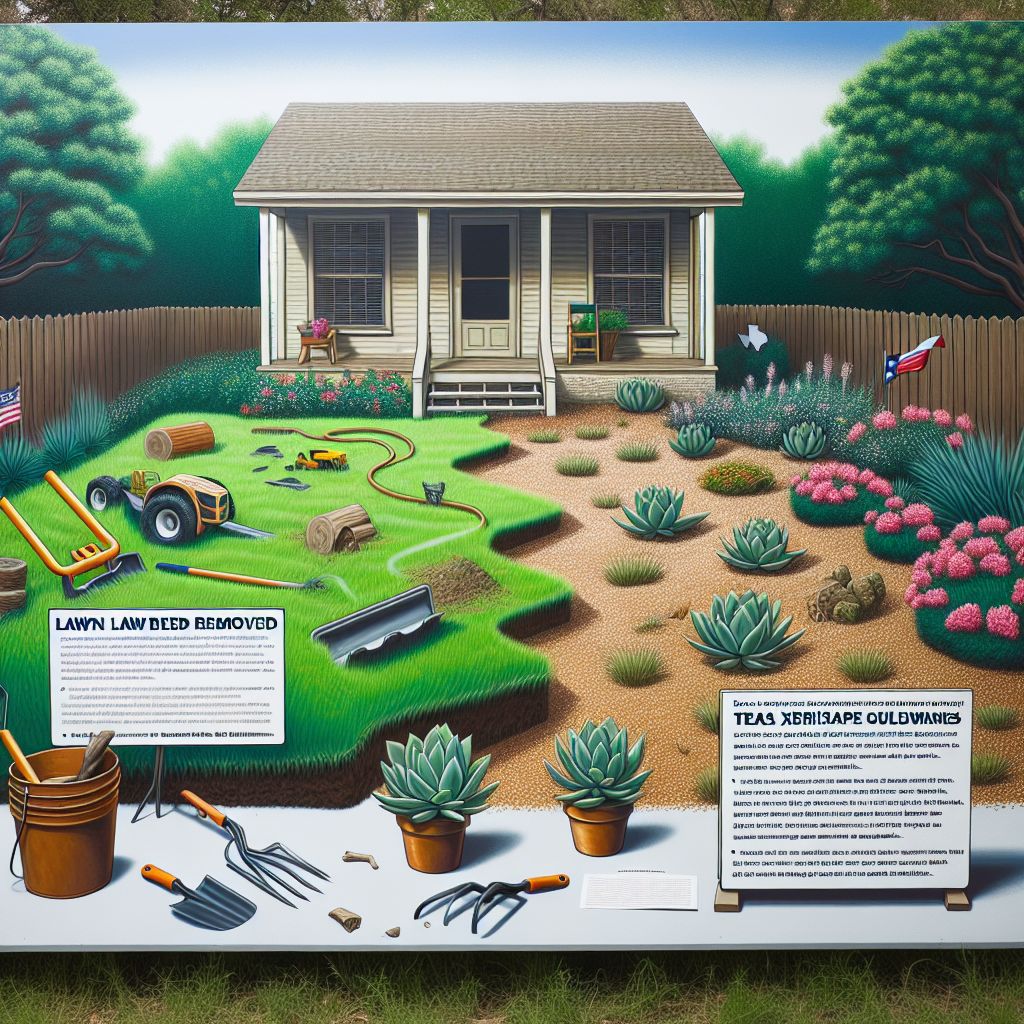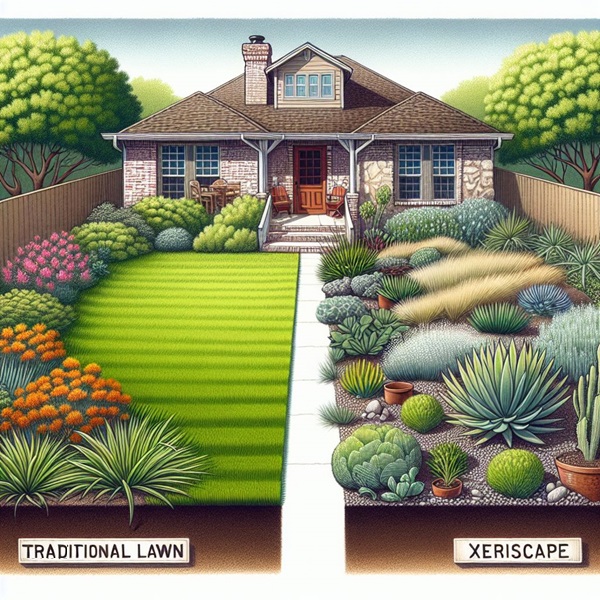
Key Takeaways
- Xeriscaping in Texas can save water, reduce maintenance, and enhance property value.
- Choosing native and drought-tolerant plants is crucial for a successful xeriscape.
- Understanding Texas laws and homeowners association rules is essential before starting.
- Designing a xeriscape involves planning for soil, irrigation, and plant placement.
- Maintenance of a xeriscape is straightforward with the right seasonal care practices.
The What and Why of Xeriscaping: A Quick Dive
Imagine stepping outside to a garden that’s not just a feast for the eyes but a boon for the planet. That’s the heart of xeriscaping—a way of landscaping that minimizes water use by relying on plants suited to the local environment. And in Texas, with its stretches of dry land and scorching summers,
So, why xeriscape? Well, for starters, it slashes your water bill, and who wouldn’t love that? But it’s not just about cost. Xeriscaping curbs water waste, a must in areas prone to drought. It’s also about creating a space that thrives with minimal fuss, meaning less mowing and more enjoying. Plus, it’s a magnet for local wildlife, inviting nature right to your doorstep.
But here’s the kicker: a xeriscaped yard can be a stunner. Gone is the notion that these spaces are dull and barren. With a palette of native plants, your garden becomes a tapestry of color and texture that changes with the seasons. And the best part? You’re crafting a slice of nature that’s sustainable and kind to the Earth.
Legal Landscape: Navigating Texas Lawn Conversion Laws
Before you grab your shovel and start transforming your lawn, let’s talk legality. In Texas, it’s not just about what you want but what’s allowed. You see, some areas have specific guidelines on landscaping—rules that ensure neighborhoods maintain a certain look.
Most importantly, you’ll want to check with your local homeowners association (HOA) or municipal codes. Some HOAs have restrictions on the amount of non-turf area you can have, while others might require approval for landscape changes. But don’t let this discourage you. Many cities in Texas encourage xeriscaping and may even offer incentives for water-wise gardening.
Therefore, arm yourself with knowledge. A quick chat with your HOA or a visit to your city’s website can save you a world of hassle. And remember, these rules aren’t there to stifle your creativity but to keep the community thriving, just like your soon-to-be xeriscape.
Example: The City of Austin offers a rebate program for residents who convert their lawns to xeriscaping, demonstrating the local support for sustainable landscaping practices.
Choosing the Right Plants for Your Xeriscape
Now, let’s talk plants—the stars of your xeriscape. The goal here is to pick species that are right at home in Texas’s climate. These plants have adapted to the local conditions, so they’ll need less water, fewer chemicals, and less of your time to stay healthy.
But where do you find these plant superstars? Start with your local nursery, where experts can guide you to the best choices for your area. They’ll introduce you to a world of native grasses, flowers, and shrubs that will make your garden pop without popping your water bill.
And when you choose native, you’re not just making life easier. You’re also providing a habitat for local wildlife. Birds, bees, and butterflies all benefit from a garden full of native plants. It’s like you’re throwing a party and everyone’s invited—especially the critters that help your garden grow.
Here’s a quick list of Texas-friendly plants to get you started:
| Plant Name | Water Needs | Sunlight | Soil Type | Height | Reference (links) |
|---|---|---|---|---|---|
| Rosemary | Low | Full sun | Well-drained | 1-5 ft | [1] |
| Thyme | Low | Full to partial sun | Well-drained | 6-12 in | [1] |
| Lavender | Low | Full sun | Well-drained, sandy | 1-3 ft | [1] |
| Oregano | Low | Full sun | Well-drained | 1-2 ft | [1] |
| Agave | Low | Full sun | Well-drained | 2-5 ft | [1] |
| Aloe Vera | Low | Full sun | Well-drained, sandy | 1-2 ft | [1] |
| Century Plant | Low | Full sun | Well-drained | 6-10 ft | [1] |
| Red Yucca | Low | Full sun | Well-drained | 3-4 ft | [2] |
| Texas Sedge | Low | Partial shade | Well-drained | 10-12 in | [2] |
| Desert Willow | Low | Full sun | Well-drained | 15-25 ft | [2] |
| Texas Mountain Laurel | Low | Full sun | Well-drained, alkaline | 10-15 ft | [2] |
| Firebush | Moderate | Full sun | Well-drained | 3-5 ft | [5] |
Blueprint for Success: Designing Your Xeriscape Garden
Designing your xeriscape is like painting a picture with plants. You’re the artist, and your palette is the array of native plants that flourish in Texas. Start with a sketch, outlining areas for trees, shrubs, and flowers, as well as paths and features like rocks or water elements. This plan will be your guide, ensuring that each plant has its place and purpose.
Consider the sun and shade in your yard throughout the day, as this will affect what plants will thrive where. Group plants with similar water needs together to make irrigation more efficient. And don’t forget about mulch—it’s not just a pretty finishing touch; it helps retain moisture and keeps those weeds at bay.
When you design with intention, you create a garden that’s not only a pleasure to look at but also a cinch to maintain. And that means more time to kick back and enjoy the fruits of your labor.
Budgeting Your Xeriscape Transformation: What to Expect
Let’s talk turkey—or rather, cactus. Xeriscaping can be cost-effective, but you’ll want to budget carefully to avoid surprises. The costs can vary widely, depending on the size of your yard, the plants you choose, and whether you’re doing the work yourself or hiring a pro.
Here’s a ballpark for what you might expect to spend:
- Plants: $2-$20 per plant, depending on the type and size.
- Mulch: Around $25 per cubic yard.
- Soil amendments: $30-$50 per cubic yard.
- Irrigation system: $300-$1,500, if you opt for a drip system.
- Professional design and installation: $1,500-$10,000+, based on complexity and size.
Remember, you might be eligible for rebates or incentives from your city or water provider, which can help offset these costs. And in the long run, the water savings will keep more green in your pocket.
Preserving Paradise: Ongoing Care for Your Xeriscape Garden
Your xeriscape is in, and it’s looking sharp. But even low-maintenance gardens need a little TLC to stay that way. The good news is that caring for your xeriscape is more about smart planning than back-breaking work.
Simple Upkeep: Seasonal Maintenance Must-Dos
With each season, your xeriscape garden has different needs. Here’s a quick guide to keep it looking its best:
- Spring: Time to prune and mulch. This sets up your plants for robust growth and helps retain moisture as temperatures rise.
- Summer: Keep an eye on watering. Even drought-tolerant plants need a drink during the peak of Texas heat.
- Fall: A great time to plant new additions, giving them a chance to establish roots before the summer heat returns.
- Winter: Protect sensitive plants from frost and freeze. A bit of burlap or frost cloth can make all the difference.
Staying on top of these tasks means your xeriscape will continue to flourish, year after year.
Resilient Beauty: Tackling Common Xeriscape Challenges
Even the best-planned gardens can hit snags. Maybe it’s an unusually wet season that’s got your cacti frowning, or perhaps an insect has taken a liking to your
Remember, xeriscaping is about working with nature, not against it. So, adjust as needed, and your garden will be all the stronger for it.

FAQ: Your Inquiries About Texas Xeriscape and Lawn Removal Addressed
Is Xeriscaping Compulsory in Texas?
No, xeriscaping isn’t mandatory, but it’s highly encouraged. With water conservation a growing concern, many cities offer incentives to homeowners who choose to xeriscape. Plus, it’s just a smart way to garden in the Texas climate.
Can Xeriscaped Gardens Be Colorful?
Absolutely! Xeriscaping doesn’t mean a sea of brown and green. With the right plant selection, your garden can be a riot of color. Think vibrant Texas Sage, fiery Red Yucca blooms, and the sunny faces of Blackfoot Daisies.
How Does Xeriscaping Impact Property Value?
It’s a common question: will xeriscaping affect my home’s value? The answer is yes, and for the better. A well-designed xeriscape can boost curb appeal and make your property stand out. Buyers are increasingly eco-conscious, and a sustainable, low-maintenance garden is a selling point. Plus, the water-saving aspect of xeriscaping is a boon in Texas, where water costs can be high. In short, a xeriscape is not just good for the planet; it’s good for your wallet too.
Are There Rebates Available for Xeriscaping in Texas?
Yes, many Texas cities and water utilities offer rebates and incentives for xeriscaping. These can include discounts on water-saving plants, rebates for reducing turf grass, and even free mulch programs. It’s a win-win: you save money on your xeriscape project, and the city saves water. Check with your local water utility or city conservation department to see what’s available in your area.
What Should I Do If My HOA Resists Xeriscape Changes?
If you’re facing resistance from your homeowners association, don’t lose hope. Arm yourself with information. Show them how xeriscaping can benefit the community with its water-saving and aesthetic advantages. Present a well-thought-out plan that aligns with the neighborhood’s appearance. Often, HOAs are receptive when they see that xeriscaping can be both beautiful and beneficial. If needed, seek out a mediator or legal advice to find a solution that works for everyone.



